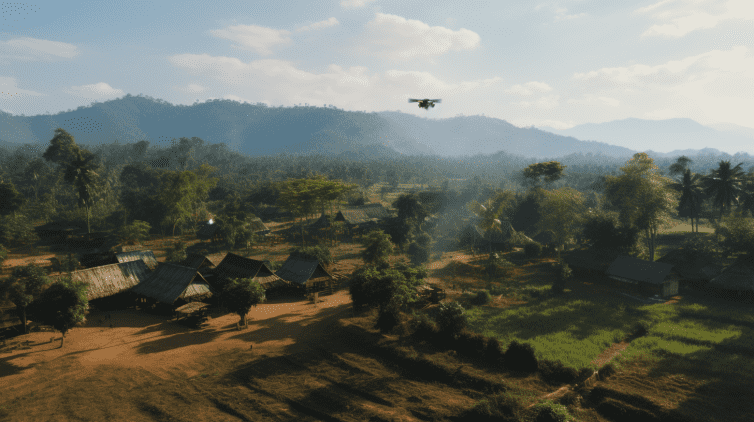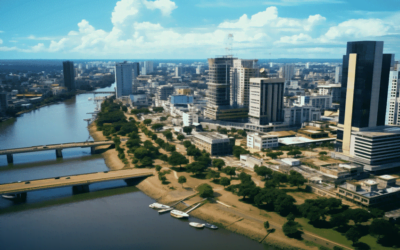Hey there, fellow drone enthusiast or traveler in Laos, I get it! You’ve probably stumbled upon this article with a burning question in mind, something like, “What are the drone laws in Laos?”
It’s a valid concern, especially if you’re planning to fly your drone here, capturing the incredible landscapes, or simply enjoying the thrill of drone flight. Well, you’re in the right place because I’ve been there too, and I understand the search intent behind your query.
I’ve spent quite some time researching the drone regulations in Laos, and I’m excited to share my findings with you. After all, drones offer a unique perspective, and knowing the rules can help you enjoy your flights without any worries.
I’ve delved deep into the specifics of Laos’ drone laws and dug up details about registration, permits, no-fly zones, and much more. So, rest assured, I’ve got the answers you’re looking for, and I’m here to guide you through the intricate web of Laos drone regulations.
So, if you’re keen to discover the ins and outs of flying your drone legally and responsibly in Laos, you’re in for a treat.
This article is your key to understanding Laos drone laws. I’ve made it my mission to provide you with clear, concise, and valuable insights that will make your drone experience in this beautiful country both enjoyable and compliant with the law. Keep reading to unlock the secrets of navigating the skies with your drone in Laos!
Registration Requirements

Alright, let’s dive into the nitty-gritty of drone registration in Laos. You know, registering your drone might not sound like the most thrilling part of your aerial adventures, but it’s crucial, and here’s why:
The Importance of Registering Your Drone
Picture this: you’re soaring above the lush forests and majestic temples in Laos, capturing breathtaking footage with your drone. It’s an exhilarating experience, no doubt, but it comes with responsibilities.
Drone registration isn’t just a bureaucratic hurdle; it’s about ensuring safety and accountability. By registering your drone, you contribute to the overall safety of the airspace and help authorities manage the ever-growing drone community. It’s like having a license for your car; it ensures that everyone on the road knows the rules and plays by them.
Details on the Registration Process with the Lao Civil Aviation Authority (LCAA)
Now that you’re on board with why registration matters, let’s talk about how to do it. In Laos, the Lao Civil Aviation Authority (LCAA) is the go-to place for all things drone-related. They’ve got the authority, and they’ve got the know-how.
So, what’s the process like? Well, it’s pretty straightforward. You’ll need to provide some basic information about yourself and your drone, such as its make, model, and serial number.
You’ll also have to clarify the purpose of your drone usage – whether it’s for recreational flights, professional photography, or something else. Remember, it’s all about keeping things transparent and making sure you’re complying with the local regulations.
Information Required for Drone Registration
Now, what specifics are they looking for when you’re filling out that registration form? You’ll need to jot down your details, like your name and contact information. They might also ask for your drone’s make and model, serial number, and weight.
If you’re using your drone for commercial purposes, expect to provide additional documentation, which is standard in many countries.
So, gather up all your drone’s details, double-check the forms, and you’ll be well on your way to becoming a registered drone operator in Laos. Remember, this is all in the spirit of safe and responsible drone flying, ensuring that your aerial escapades are enjoyable and free from hassles.
Also Read: Kyrgyzstan Drone Laws 2024
Drone Categories and Classifications

Drones come in all shapes and sizes, and how they’re regulated can often hinge on the category they fall into. It’s like having different types of driver’s licenses for motorcycles, cars, and trucks. Let’s unpack the drone categories and what they mean for you when flying in Laos.
Explanation of Different Drone Categories
First things first, let’s get familiar with the drone categories you’ll encounter in Laos. There are typically two main categories: recreational and commercial.
Recreational drone flights are for fun and personal enjoyment, while commercial flights involve any kind of financial gain, like photography services or surveying. Knowing which category your drone fits into is the foundation for understanding the applicable rules and regulations.
How Regulations May Vary Based on Drone Classification
Now, here’s where it gets interesting. Regulations often differ depending on whether you’re flying your drone for fun or for profit.
Recreational drone flights may be subject to fewer restrictions, whereas commercial drone operations might require special permits, clearances, and more stringent compliance with regulations.
The key takeaway here is that if you’re planning to use your drone for commercial purposes, it’s crucial to be well-versed in the specific rules that apply to that category.
The Role of Drone Weight and Size in Classification
But wait, there’s more to it. In addition to the recreational vs. commercial divide, drone weight and size can also play a significant role in how they are classified. Heavier and larger drones may come with additional requirements, like mandatory registration or specific flight restrictions.
It’s a bit like driving a compact car versus a big rig; the rules can be quite different. So, whether you’ve got a pocket-sized drone or a larger quadcopter, be aware of how size and weight may influence the regulations you must follow.
Understanding these nuances will go a long way in ensuring your drone flights in Laos are hassle-free and compliant with the law.
Also Read: Kuwait Drone Laws 2024
No-Fly Zones and Restricted Areas

When you’re itching to take your drone to the skies in Laos, the last thing you want is to accidentally stumble into a no-fly zone. Let’s explore these restricted areas and what happens if you venture into them without knowing.
Identification of Areas Where Drone Flights Are Prohibited or Restricted
First off, knowing where you can’t fly your drone is crucial. In Laos, there are certain areas where drone flights are either prohibited or heavily restricted. These include places near airports, government buildings, and other sensitive locations.
But, it’s not just about staying away from specific sites. You’ll need to be aware of the broader regions where drone flights might be off-limits, so having access to up-to-date maps and regulations is key to keeping your flights smooth and within legal bounds.
Proximity to Airports, Government Buildings, and Other Sensitive Locations
You know those picturesque moments you’ve seen in travel brochures, like drone shots of serene temples and lush landscapes? Well, some of those sites are near government buildings or airports.
While it’s tempting to capture these amazing sights, it’s vital to recognize that flying your drone too close to such places is often not allowed. The last thing you want is to have an unplanned encounter with the authorities when your drone happens to wander into restricted airspace.
Consequences of Flying in Restricted Areas
Now, let’s talk about the consequences. If you inadvertently venture into a restricted area or a no-fly zone, you might find yourself facing some unpleasant repercussions. This could range from warnings and fines to confiscation of your drone or even legal action.
The severity of these consequences may depend on the specific violation and local authorities’ discretion. So, it’s not just about understanding the rules; it’s about heeding them to ensure your drone adventures in Laos are free from unnecessary complications and legal entanglements.
Also Read: Kosovo Drone Laws 2024
Licensing and Permits

Now, here’s where it gets a bit more complex, but don’t worry, I’m here to break it down for you. Licensing and permits are vital components of flying a drone in Laos. Let’s dive into the world of permissions and procedures.
Requirement for Permits for Certain Drone Operations
Not all drone operations in Laos require permits, but some do. If you’re planning to use your drone for commercial purposes, like aerial photography or surveying, you’ll likely need a permit.
It’s all about the nature of your activities and whether you’re generating any income from your drone flights. For recreational use, you typically won’t need a permit, but it’s crucial to know when you cross that line into commercial territory.
Procedures for Obtaining Permits, Including Documentation and Fees
Now, let’s talk logistics. If you’re diving into commercial drone operations, you’ll have to navigate the permit application process. It may involve filling out forms, providing documentation related to your drone and your business, and, of course, paying fees.
The specifics can vary but be prepared to demonstrate your competence, safety measures, and the value of your drone services to get that all-important permit.
Specifics for Commercial Drone Operators
For those in the commercial drone game, there are often additional requirements. This might include having insurance coverage, displaying identification markings on your drone, and adhering to more stringent regulations.
The aim is to ensure that your operations are safe, professional, and accountable. So, whether you’re snapping photos from the sky for fun or profit, understanding the licensing and permitting process in Laos is essential to keep your flights smooth and in line with the law.
Also Read: South Korea Drone Laws 2024
Operating Guidelines

Okay, so you’ve got your drone, and you’re itching to take it for a spin. But before you launch into the skies of Laos, let’s talk about some vital operating guidelines to keep things smooth, safe, and respectful.
General Rules for Responsible Drone Operation
Whether you’re a seasoned pilot or just starting a responsible drone operation is a must. Keep an eye on your drone at all times, and ensure it’s in good working condition.
Avoid flying your drone too close to other aircraft, and always be aware of your surroundings. Following these general rules will help you become a responsible and considerate drone operator, ensuring a pleasant experience for everyone sharing the airspace.
Safety Considerations and Best Practices
Let’s prioritize safety. Remember to respect privacy, avoid flying over private properties without permission, and steer clear of sensitive areas and crowded places. Safety also involves checking the weather conditions before taking off and being mindful of your drone’s battery life. Oh, and don’t forget about other people! Always ensure you’re not putting anyone at risk during your flights.
Maintaining a Safe Distance from People and Property
This one’s a biggie. Keeping a safe distance from people and property is non-negotiable. It’s about protecting both your drone and others.
Avoid buzzing your drone too close to people’s heads or property. It’s a simple gesture that goes a long way in promoting safe and enjoyable drone flights.
So, whether you’re capturing incredible vistas or filming an event, make safety your top priority. By adhering to these operating guidelines, you’ll be able to explore the skies of Laos with confidence and responsibility.
Also Read: North Korea Drone Laws 2024
Privacy and Ethical Considerations

Alright, as drone enthusiasts, we’ve got the world at our fingertips, quite literally. But with great power comes great responsibility. When it comes to drones, respecting privacy and being ethically aware are essential.
Respecting Individuals’ Privacy and Property Rights
Imagine you’re out flying your drone, capturing amazing footage, and you suddenly realize you’re getting a bit too close to someone’s private space. It’s a situation you’d rather avoid, right? Respecting individuals’ privacy and property rights is a non-negotiable part of responsible drone operation.
Always maintain a safe distance from people’s homes, backyards, and personal lives. It’s all about being considerate and ensuring that your drone flights don’t intrude on someone’s private sanctuary.
Ethical Considerations When Capturing Images or Videos with Drones
Drones offer a unique perspective, and that’s fantastic for photography and videography. However, it’s important to consider the ethical aspects. When capturing images or videos with your drone, be mindful of what you’re capturing.
Avoid taking shots that invade someone’s privacy, whether it’s an unsuspecting neighbor or a random passerby. Think about how you’d feel if you were on the other side of the camera, and that’ll guide you toward ethical drone operation.
Potential Legal Consequences for Privacy Violations
Privacy is not just about being ethical; it’s also a legal matter. If you violate someone’s privacy with your drone, you could find yourself facing legal consequences. Laws in Laos, as in many places, are in place to protect individuals from unwarranted intrusion.
So, take these matters seriously. Avoid capturing images or videos that could land you in hot water legally. By respecting privacy and being ethically conscious, you can ensure that your drone flights contribute positively to the world around you.
Also Read: Kiribati Drone Laws 2024
Customs Regulations

Now, let’s talk about what happens before your drone takes its first flight in Laos. Understanding customs regulations is crucial for a smooth entry.
Information on Importing Drones into Laos
You’ve got your drone and are all set to explore the stunning landscapes of Laos. But before you pack your bags, you need to know the deal with importing drones.
The good news is that Laos generally allows the import of drones for personal use. However, if you’re bringing in multiple drones or have commercial intentions, things might get a bit more complicated. Always do your research to understand what’s allowed and what might need special permissions.
Customs Procedures and Any Associated Fees
Navigating customs procedures can sometimes feel like a maze, especially when it comes to technical gadgets like drones. It’s advisable to check with Laos customs authorities to understand the specific requirements and any associated fees.
While bringing in your drone usually doesn’t involve hefty fees, commercial operators may face different rules and costs. Ensuring you’re well-prepared in advance can save you time and potential hassles at the border.
Declarations and Documentation Required for Bringing Drones into the Country
Paperwork – a word that often elicits sighs. When it comes to bringing drones into Laos, declarations and documentation are par for the course. For personal drone use, you’ll typically need to provide clear information about your drone, including its make, model, and purpose.
The idea is to ensure transparency and accountability. For commercial drone operations, expect more detailed documentation, which is pretty standard worldwide.
Always check with the latest customs regulations to make sure you have all your ducks in a row before crossing the border. By being well-informed and prepared, you can ensure a hassle-free start to your drone adventures in Laos.
Also Read: Kenya Drone Laws 2024
Insurance Requirements

Insurance might not be the most exciting topic, but it’s a crucial aspect of responsible drone operation. Let’s explore why insurance matters in the world of drones.
The Importance of Liability Insurance for Drone Operators
When you’re piloting a drone in the skies of Laos, it’s essential to consider liability insurance. Accidents can happen, and drones can sometimes go off-course. Liability insurance serves as a safety net in case of unexpected mishaps.
Whether it’s property damage or personal injury, having coverage can save you from potentially hefty expenses and legal troubles. It’s like having a safety harness when you’re climbing a steep slope – you hope you won’t need it, but it’s there just in case.
Coverage Options and Where to Obtain Insurance
So, where can you get this important insurance? Many insurance providers offer drone liability coverage. You can check with local insurers or even explore options online. The key is to understand what coverage suits your needs and budget. Policies can vary, so it’s a good idea to compare different options to find the one that fits you best.
Liability in the Case of Accidents or Incidents
Now, let’s talk about what happens when things don’t go as planned. In case of accidents or incidents involving your drone, your liability insurance will come into play. It will help cover costs related to property damage or injuries caused by your drone.
Remember, the legal and financial consequences of accidents can be significant, so having insurance in place offers peace of mind and ensures responsible drone operation. Think of it as your safety net when you’re up in the air. By considering liability insurance, you’re taking a proactive step toward responsible and accountable drone flights in Laos.
Also Read: Kazakhstan Drone Laws 2024
Recent Changes and Updates

Staying in the loop when it comes to drone regulations is a smart move. Regulations can change, and it’s essential to know what’s new. Here’s a quick peek at recent changes and what they might mean for drone enthusiasts and operators in Laos.
Any Recent Amendments or Developments in Drone Regulations in Laos
Regulations aren’t set in stone; they can evolve. In Laos, there might have been recent amendments or developments in drone regulations. These could include updates related to registration, permits, no-fly zones, or other operational aspects. Being aware of these changes is vital to ensure you’re always flying within the bounds of the law.
Potential Impacts on Drone Enthusiasts and Operators
Now, let’s talk about the implications. Any recent changes in regulations could impact drone enthusiasts and operators in various ways. This might mean stricter requirements for permits or updated restrictions on certain areas.
Staying informed is key to adapting to these changes and ensuring you’re always in compliance. By keeping your finger on the pulse of recent developments, you can continue enjoying your drone adventures while respecting the law and fostering a safe and responsible drone community in Laos.
Also Read: Jordan Drone Laws 2024
Final Thoughts on Laos Drone Laws

As we wrap up our journey through the intricate skies of Laos drone laws, let’s take a moment to revisit the key takeaways and emphasize why it all matters.
Summarize the Key Points of the Article
In this article, we’ve delved into the world of drone regulations in Laos. We’ve covered everything from registration requirements to operating guidelines and even the importance of insurance. We’ve explored how recent changes might impact your drone adventures.
It’s a lot to digest, but remember, knowledge is power, and understanding these regulations is the key to enjoying your drone flights in Laos while respecting the law.
Emphasize the Importance of Complying with Drone Regulations in Laos
Now, let’s talk about why compliance is crucial. Drone regulations exist for a reason: safety and accountability. By adhering to these rules, you not only protect yourself but also contribute to the safety of others in the airspace and on the ground.
Compliance ensures that your drone flights are hassle-free and free from legal troubles. It’s like having a smooth flight plan for your aerial adventures in Laos.
Encourage Responsible and Safe Drone Usage
Lastly, I encourage all drone enthusiasts to fly responsibly and safely. Whether you’re capturing stunning landscapes, documenting events, or simply enjoying the thrill of flight, always keep safety and ethical considerations in mind.
Respect privacy, maintain a safe distance from people and property, and be a responsible drone operator. By doing so, you can contribute to a positive and thriving drone community in Laos. So, take to the skies, enjoy your drone adventures, and always remember to fly high and fly smart.
Also Read: Japan Drone Laws 2024
Frequently Asked Question
1. Can I fly my drone in Laos without registering it?
No, you must register your drone in Laos, regardless of whether it’s for recreational or commercial use. Registration helps ensure safety and accountability in the airspace.
2. What are the specific requirements for registering a drone in Laos?
To register your drone in Laos, you’ll typically need to provide personal details, drone information (make, model, serial number), and clarify the purpose of your drone usage. Commercial operators may need to submit additional documentation.
3. Are there no-fly zones in Laos for drones?
Yes, there are no-fly zones in Laos, which can include areas near airports, government buildings, and sensitive locations. It’s essential to consult up-to-date maps and regulations to avoid these restricted areas.
4. Do I need insurance for my drone in Laos?
Liability insurance is strongly recommended for drone operators in Laos. It serves as a safety net in case of accidents, covering property damage or personal injury. Commercial operators often require insurance.
5. How can I stay updated on recent changes in Laos drone regulations?
To stay informed about recent changes and updates in Laos drone laws, it’s advisable to regularly check with local aviation authorities and government sources. Being aware of any amendments ensures that you’re always flying within the bounds of the law.













